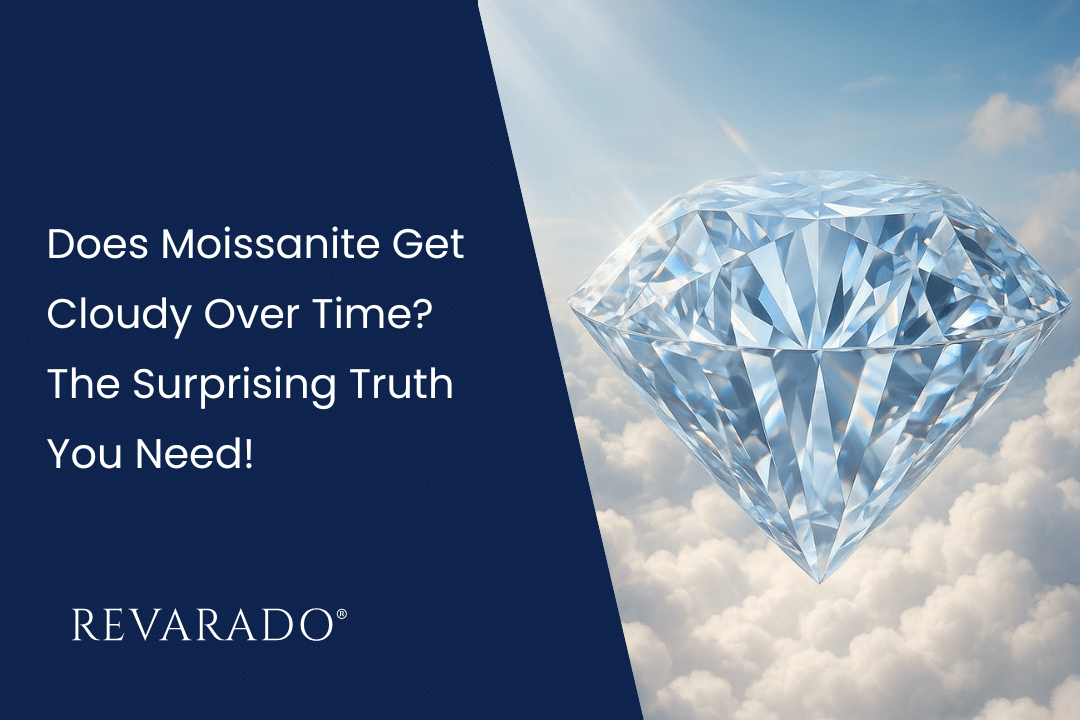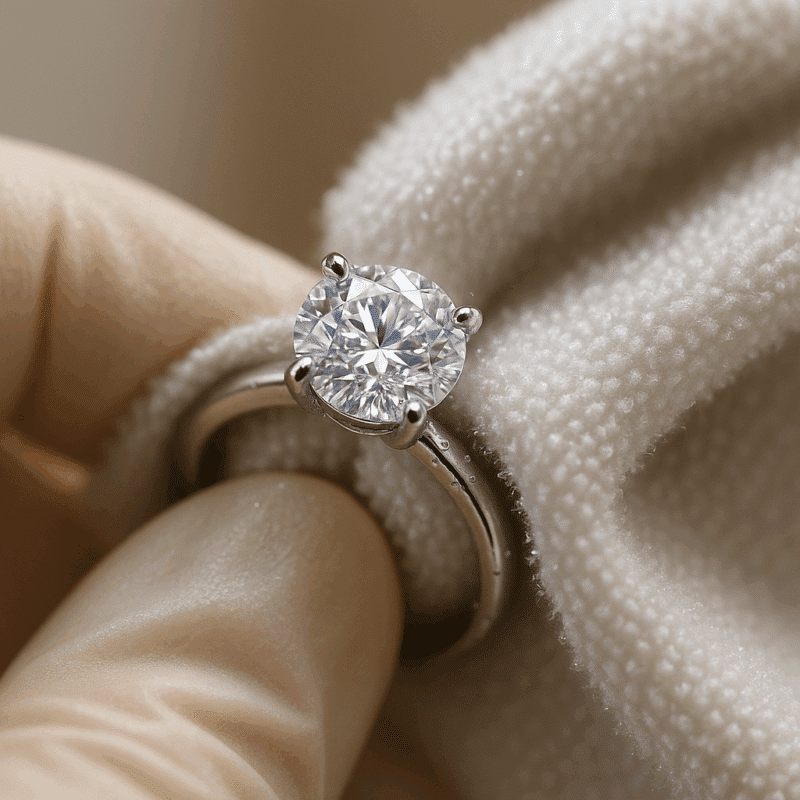Does Moissanite Get Cloudy Over Time? The Surprising Truth You Need!

Moissanite has surged in popularity as a diamond alternative, but a common concern persists: Does moissanite get cloudy or hazy over time? The short answer is “NO!” and in this article, we delve into the science and expert insights to answer this question. We examine moissanite’s gemological properties, distinguish between temporary surface dullness and true cloudiness, and compare moissanite with diamonds and cubic zirconia. The findings consistently show that moissanite itself does not become permanently cloudy – any loss of sparkle is usually due to surface residues that can be cleaned off. Below, we explore why this is the case and how moissanite stands up to the test of time.
Moissanite’s Gemological Properties and Cloudiness
What is moissanite made of? Moissanite is a lab-created gemstone composed of silicon carbide (SiC). This gives it exceptional physical and optical properties. It ranks about 9.25 on the Mohs hardness scale – just below diamond’s 10 – making it one of the hardest gemstones in existence. Such hardness means moissanite is extremely resistant to scratching or abrasion, which is key to preventing any permanent hazy appearance. Unlike softer gems, it’s non-porous and not easily scratched, so there are no tiny crevices or micro-scratches for grime to seep into and cause internal dullness. In other words, moissanite’s crystal structure stays intact and will not lose clarity or develop a permanent cloudy appearance – even decades later.
Optical brilliance vs. “cloudiness”: Moissanite is known for its high refractive index and doubly refractive optical character, which splits light into two rays. This causes an intense “disco ball” sparkle with rainbow flashes. Some observers unfamiliar with moissanite might mistake this effect for a slight fuzziness or “cloud” when looking closely, since the stone’s facets can appear doubled. However, this is not actual cloudiness or damage, just a natural optical trait. In fact, moissanite gems are typically very clear (often graded VVS or better in clarity) because they are grown in controlled lab conditions. They lack the minute inclusions or internal fractures that might make a natural stone look milky. Scientifically, silicon carbide is also chemically stable, meaning it doesn’t react or degrade with exposure to everyday chemicals or environmental factors. Overall, the gemological consensus is that moissanite’s hardness and stability prevent it from becoming cloudy internally. Any loss of visual brightness usually has an external cause, as we discuss next.
Temporary Surface Dullness vs. Permanent Clouding
It’s important to distinguish between a gemstone that truly clouds from within versus one that just looks dull because it’s dirty. Moissanite itself will not become cloudy from within over time. However, like any jewelry, a moissanite ring can collect films of oils, soap, hard water, or cosmetics on its surface. This buildup can make the stone look milky or less brilliant. The good news is that such a hazy film is only temporary and superficial. As an expert jeweler notes, “Moissanite is very stable and durable… it will not become cloudy or lose its sparkle over time. Like any jewelry, it can accumulate oils and dirt from daily wear, which might temporarily reduce its brilliance, but regular cleaning will easily restore its sparkle.”. In essence, if your moissanite appears cloudy, it almost certainly just needs cleaning, not replacement.
Why doesn’t grime cause permanent damage to moissanite? The gemstone’s non-porous, scratch-resistant nature means dirt and oils remain on the surface rather than penetrating the stone. By contrast, softer gems can absorb grime or get microscratches that trap debris, leading to a lasting haze. For example, “many softer gemstones will quickly begin to lose their sparkle the longer they are worn” because their pores or scratches give “tiny spaces for grime to build up over time” that can’t be fully removed. Moissanite avoids this fate – any gunk stays on the exterior where it can be wiped away. Even if a moissanite looks a bit dull after months of wear, a brief soak and gentle scrub will bring it back to full brilliance. No inherent clouding is taking place within the crystal.

Do moissanite rings get cloudy? No. Routine cleaning of a moissanite engagement ring with mild soapy water and a soft brush removes surface residue. Regular care ensures the stone’s temporary dullness from daily grime is washed off, restoring its full sparkle.
Basic maintenance is straightforward: clean your moissanite periodically by soaking it in warm water with a few drops of dish soap, gently brushing the stone, and rinsing it clean. Avoid harsh chemicals like bleach or chlorine, which could leave a film or damage ring metal (while moissanite itself is chemically resilient, it’s wise to protect the whole piece). Most owners find that a quick at-home cleaning every so often keeps their moissanite as fiery as ever. Jewelers also often offer professional ultrasonic cleaning if needed, but this is rarely necessary unless a heavy film has built up. In summary, moissanite’s “cloudiness” is nearly always just dirt – temporary and completely reversible with cleaning. The stone’s core clarity and sparkle remain unchanged over time.
Moissanite vs. Diamond vs. Cubic Zirconia: Cloudiness and Durability
How does moissanite compare to other popular clear gemstones in terms of clouding or dulling over time? Let’s look at diamonds and cubic zirconia, two other common choices for “diamond-like” jewelry stones:
- Diamonds: Diamonds do not get permanently cloudy with time; like moissanite, a real diamond’s sparkle can dim if it’s covered in oils or dirt, but the fix is simply cleaning. In normal use, a diamond will “last a lifetime” without losing its optical properties. Note that some diamonds have internal inclusions called “clouds,” but these are innate flaws, not something that develops with wear. In fact, jewelers often note that any well-cut, hard gemstone (diamond or moissanite) will only appear cloudy if it’s dirty, not because the stone itself degrades.
- Cubic Zirconia (CZ): CZ is much softer (around 8–8.5 on the Mohs scale) and less stable. This leads to two issues: scratches and absorption of oils. Even microscopic dust can scratch CZ over the years, and the stone can pick up oils or chemicals that aren’t easily removed. Over a few years of wear, even a top-grade CZ will usually develop a permanent hazy or scratched look. In short, CZ’s sparkle is often temporary – it might mimic a diamond initially, but it lacks long-term resilience.
Neither moissanite nor diamond will turn cloudy internally over time. The main difference you might notice is optical: moissanite’s double refraction gives more rainbow flashes, whereas diamonds show a crisper white sparkle. Meanwhile, cubic zirconia is beautiful initially but will likely dull with age in a way that moissanite won’t.
Real-World Experiences from Moissanite Owners
Beyond lab tests and expert opinions, what do everyday wearers say? Most long-term moissanite owners report that their stones remain as sparkly and clear as when they first got them, aside from needing the occasional cleaning. For instance, one user on a jewelry forum shared that her moissanite engagement ring from a well-known vendor never looked cloudy at all after a year of wear, and simple regular cleaning kept it brilliant. Many others say the same up to several years in – no yellowing, fogging, or loss of fire. This aligns with the fact that moissanite’s properties don’t degrade. As one collector put it, “I’ve worn my moissanite ring daily for years and it still looks like new – I just give it a quick soap-and-water scrub when it gets dirty, and it sparkles like crazy again.”
Conclusion: Moissanite Stands the Test of Time
After examining scientific data, expert testimony, and real user experiences, the verdict is clear: moissanite does not get cloudy over time. This gemstone’s hardy nature – high hardness, lack of porosity, and chemical stability – ensures that it retains its optical clarity and brilliance for the long haul. Any cloudiness or dullness that might appear on a moissanite is almost always due to surface buildup from everyday life (lotions, oils, soap, etc.), and this is a temporary condition easily reversed with proper cleaning. Unlike CZ, that do become permanently scratched or hazy after a few years, moissanite is built to endure.
For consumers worried about cloudiness, the key takeaways are: choose Revarado’s moissanite jewelry and keep them clean. Our high-grade moissanites are perfectly clear and will stay that way.